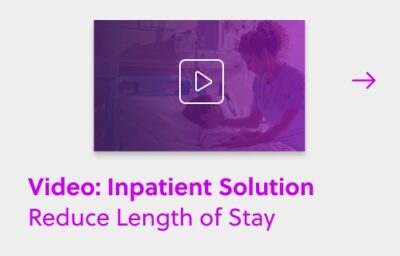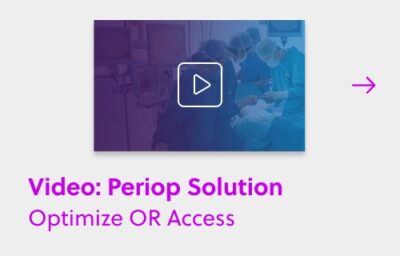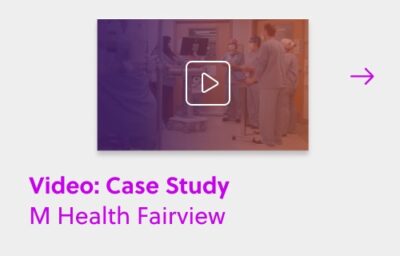It’s a hard time to run an OR. Most OR leaders are trying to keep up with increased patient needs while navigating staffing shortages and trying to keep things running via inefficient manual processes that include a barrage of emails, phone calls, and faxes to get a case on the books. Not to mention a lack of real-time insights that are critical to operating efficiently and optimizing the resources they have available. Juggling all of this while trying to meet growth goals and achieve key health system initiatives is a major challenge.
To continue meeting the needs of the communities they serve, OR leaders need to focus on strategic growth. But that’s often an afterthought when most of their time is spent on handling the challenges described above. Thankfully, recent innovations in machine learning and artificial intelligence are making it easier for ORs to find open time, schedule cases digitally, and unlock key insights that help drive decision making. As a result, developing a strategy for thoughtful OR growth has never been more attainable. Here are 5 steps you can take to achieve thoughtful surgical growth and improve your OR efficiency in the process.
1. Select Your Growth Strategy
The foundation of achieving sustainable surgical growth begins with a well-defined strategy. It’s crucial to identify the types of procedures that align with your health system’s goals and patient needs. Factors such as community health demands, revenue potential, and technological investments (like robotic surgery capabilities) should guide this decision-making process. Once you’ve taken the time to think through how you want to grow, you will be able to more easily make decisions that contribute to that strategy, and avoid a “growth at all costs” mentality that can lead to inefficient growth that doesn’t help you achieve your key goals. By focusing on specific growth areas, OR departments can allocate resources more efficiently and maximize their impact on patient care.
2. Leverage Personalized Machine Learning Models and Artificial Intelligence
Once you’ve aligned on the right strategy to best serve your community and meet health system goals, you need to put that strategy into action. Recent advancements in artificial intelligence have enabled OR leaders to have more control over what cases take priority in the schedule.
For example, with the Qventus Perioperative Solution, our models can be tailored to your strategy, so that each surgeon, service line, and OR location are taken into consideration to optimize OR scheduling and ensure the right cases are taking place in the right rooms at the right times – greatly enhancing efficiency and utilization rates. A few examples of how this is applied within our solution:
- Machine learning models identify block time that is unlikely to be utilized, and send personalized nudges to the block owner encouraging them to release that time. The nudges also provide important context, including the predicted likelihood that the surgeon will need the time and the positive impact that releasing the time will have on their block utilization. These models have helped Banner Health release 359 hours of block time early each month.
- Once block time is released, our Available Time Outreach algorithms proactively market that time to the best-fit surgeon who is most likely to fill the time with cases that you have deemed important to your growth strategy. The algorithms factor in surgeons’ previous practice patterns, as well as case mix, to determine who the time should be marketed to. This helps OR leaders quickly fill open time with cases that make sense strategically.
- TimeFinder, Qventus’ digital scheduling interface, helps streamline scheduling – allowing schedulers to find and book open time in seconds and book in minutes. But more importantly, TimeFinder doesn’t just display open times chronologically. It prioritizes open time slots based on factors like estimated case length, procedure type, and surgeon preferences. Making it easy and frictionless for schedulers to book the time slot that makes the most sense for each case is critical for optimizing the OR schedule and achieving strategic growth.
3. Engage with Surgeon Offices
Building strong relationships with surgeon offices and schedulers is crucial for attracting more cases to your health system. If you can win the surgeon schedulers by providing a better experience than other health systems, you’ll drive more cases to your system. Providing a seamless, digital scheduling interface that prioritizes efficiency and flexibility – like TimeFinder – helps make your health system the first choice for surgeons and schedulers.
In addition, engaging with surgeon offices is critical to maintaining a healthy referral stream. By analyzing claims data, like that available from Qventus’ Market Insights Suite, you can identify practices that are referring high-value cases to other systems and develop a strategy to grow your referral base. Our Perioperative Solution also includes features like Referral Automation that can automate outreach to practices you are targeting for referrals.
4. Maximize Use of High-Value Assets
High-value assets such as surgical robots are invaluable tools that often end up being underutilized due to inefficient resource allocation. We’ve found that 35% of robotic room time ends up being used for non-robotic cases, which is terribly inefficient. If robotic cases are a core component of your growth strategy, you can’t afford to have your robots going unutilized so often. With Qventus, our algorithms can identify when a non-robotic case is scheduled in a robotic room, and automatically search for other rooms that the case can be moved to without disrupting the scheduled time. Combine this with the overall increase in released block time that our Perioperative Solution generates, and you can see some impressive results. As an example, Allina Health achieved a 36% increase in robotic utilization thanks to Qventus.
5. Fill Every White Space with the Right Surgical Case
Optimizing OR utilization requires proactive management of scheduling gaps and unused block time. By leveraging technology to identify and promote available slots to surgeons likely to perform high-value procedures, health systems can maximize their surgical capacity. Early block release initiatives coupled with automated systems for marketing available time can streamline operations and ensure that every OR opportunity is utilized effectively. This enables you to schedule the right cases, in the right rooms, at the right time.
Conclusion
Thoughtful surgical growth is not just about increasing case volume, but about optimizing every aspect of OR operations—from strategic planning and resource allocation to leveraging advanced technologies and nurturing collaborative relationships with surgical teams. By implementing these five steps, OR departments can enhance efficiency, improve patient outcomes, and position themselves as leaders in delivering high-quality surgical care. If you’re ready to unlock strategic surgical growth at your health system, schedule a call with our perioperative experts. We’d love to discuss your current state, learn about your OR goals, and develop a plan to help you achieve them.


